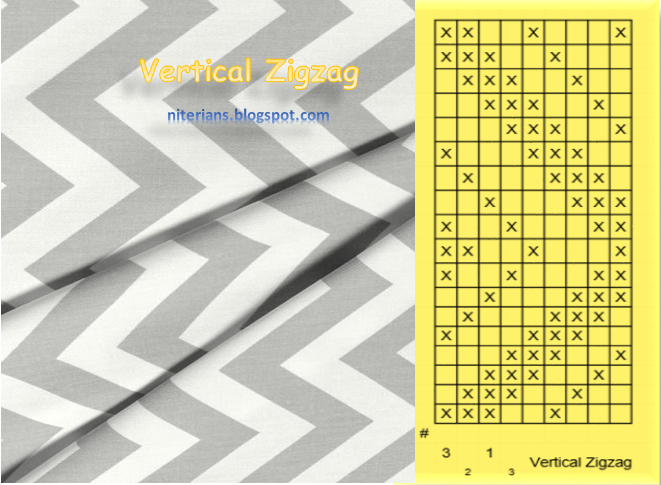Derivatives of Twill Weave
Derivatives of Twill Weave
Derivatives of Twill Weave
# Definition of Twill Weave:
A weave that repeats on three or more picks and produces diagonal lines on the face of the fabric is called Twill Weave. Twill Weave also can be defined as “The order of interlacing which causes diagonal lines of warp and weft floats to be formed on the cloth.
Written by
Md. Masudur Rahman
Department of Textile Engineering
4th Batch
National Institute of Textile Engineering and Research (NITER)
Derivatives of Twill Weave:
1. Zig-Zag Twill (read more)
2. Herring Bone Twill
3. Diamond Design
4. Diaper Design
5. Shaded Twill
6. Broken Twill
7. Combined Twill.
8. Stepped or Elongated Twill
9. Rearranged Twill
2. Herring Bone Twill
3. Diamond Design
4. Diaper Design
5. Shaded Twill
6. Broken Twill
7. Combined Twill.
8. Stepped or Elongated Twill
9. Rearranged Twill
* A point is created in reversing point. So, it is sometimes referred to as Pointed Twill.
* Uses: Figured or ornamented design, Upholstery, Wall covering etc.
#Types:
1. Horizontal Zigzag
2. Vertical Zigzag
#Features of Horizontal Zigzag:
* Point draft is used for this design.
#Features of Vertical Zigzag:
* The number of weft yarn is double to the number of warp yarn in the repeat.
* Straight draft is used for this weave.
2. Herring Bone Twill
* This twill shows an appearance of Herring Bone.
* It has the similarity with the zigzag twill up to half of the repeat, but while changing the direction the interlacement becomes quite opposite to that of the zigzag twill.
* Normally Straight draft is used.
* Uses: Suiting, over coating, ornamented fabrics.
#Types of Herring Bone Design:
* It has the similarity with the zigzag twill up to half of the repeat, but while changing the direction the interlacement becomes quite opposite to that of the zigzag twill.
* Normally Straight draft is used.
* Uses: Suiting, over coating, ornamented fabrics.
#Types of Herring Bone Design:
a. Horizontal Herring Bone.
 |
| Horizontal Herring Bone. |
b. Vertical Herring Bone.
 |
| Vertical Herring Bone. |
3. Diamond Design:
* Diamond design is the combination of horizontal and vertical zigzag twill.
* This design is symmetrical on both axis.
* Point draft is used to produce this design.
* The repeat size of warp and weft are equal.
* Because of large number of ends in the repeat, Dobby loom is generally referred.
* Uses: Towel, bed cover, table cover, pillow cover.
* This design is symmetrical on both axis.
* Point draft is used to produce this design.
* The repeat size of warp and weft are equal.
* Because of large number of ends in the repeat, Dobby loom is generally referred.
* Uses: Towel, bed cover, table cover, pillow cover.
4.Diaper Design:
* Diaper design is thecombination of horizontal and vertical herring bone.
* Broken or Straight draft is used to produce this design.
* The repeat size of warp and weft are equal.
* Uses: Towel, bed cover, table cover, pillow cover, handy bag etc.
* Broken or Straight draft is used to produce this design.
* The repeat size of warp and weft are equal.
* Uses: Towel, bed cover, table cover, pillow cover, handy bag etc.
5. Shaded Twill :
The shaded twill represents a gradual transition from the twill with weft effect to warp effect, and vice versa. It is used mostly in Jacquard weaving for large-pattern fabrics.
6.Broken Twill :
Broken twill is formed by break in the continuation of the twill line at predetermined intervals
7. Combined Twill
It is formed by arranging the threads of two continuous regular twill weaves alternately with each other’s. It is used for producing textures on fabric
#Features:
- Repeat size of two regular twill weaves may be equal or different.
- In combined twill no practically limitations exist and varieties of design can be produced.
- It is capable of producing compact and firm tertures. .
- In case of equal no. of base twill : 6x6, 6x6; or 8x8, 8x8.
- In case of unequal no. of base twill : 4x4, 6x6; or 8x8, 6x6.
(b) Weft face combined twil
 | |||||||||||
| (a)Warp face combined twill |
 |
| (b) Weft face combined twil |
8. Stepped or Elongated Twill
These weaves are generated by introducing a step into the design after a certain number of ends or picks. At the step, every thread changes from up to down or vice versa. This are two type stepped twill-
#Types
(a)Warp way stepped twill:
Reversal of the twill direction: Same as horizontal herringbone twill weave.
(a)Warp way stepped twill:
Reversal of the twill direction: Same as horizontal herringbone twill weave.
(b) Weft way stepped twill:
Reversal of the twill direction: Same as vertical herringbone twill weave.














Comments
Post a Comment